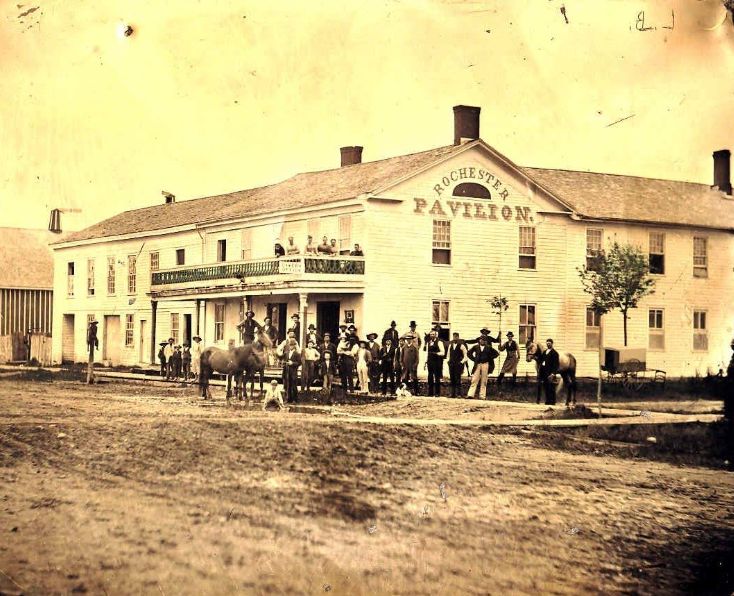Avon Township, now Rochester and Rochester Hills, was the first European settlement in Oakland County, Michigan. The first settlers came from upstate New York, New England, and southern Canada in 1817. Seeking land to clear and farm, these pioneers worked their way north from Detroit by following Native American trails through the forests and marshlands or by traveling on the Detroit River and walking overland. Settlers found heavily wooded, gently rolling land crossed by rivers and creeks.
In the era before the common adoption of the steam engine, Avon Township owed its early settlement to the convergence of three potential sources of waterpower – the Clinton River, Stony Creek, and Paint Creek. Water-powered mills were essential in providing food, clothing, and shelter, by grinding grain into flour for bread, carding wool for cloth, and cutting lumber for home and barns. By 1850, area sawmills produced 444,000 board feet of lumber and carding mills processed 28,000 pounds of wool.
Farming Operations
In its first 33 years, the population of Avon Township grew to 1,456 people and all the land was privately owned. The family farms were largely self-sufficient, producing most of their own food and clothing by 1850. As more land was cleared, large crops could be efficiently grown and harvested for sale to other markets. However, after 1900, farmers decreased their acres of wheat and flocks of sheep. Residents began to travel by public transportation to work in city factories. By 1907, there were eight passenger and 25 freight trains stopping in Rochester every day. With fewer farm laborers, farmers had to reduce their acreage. Some even sold their land and moved to the cities. This led to a boom in land prices as farms were sold for housing subdivisions, scientific farming operations, and large estates for the wealthy.
There were several large scientific farming operations located in Avon Township. Taking advantage of convenient proximity to Detroit and rail systems were Dr. Sarah Van Hoosen Jones’ dairy and poultry farm, the Ferry-Morse Seed Co. Farm, and Parke, Davis & Company’s biological farm. Large country estates were created by the consolidation of many family farms, such as Meadow Brook Farms and Great Oaks Stock Farm.
Population Growth
In the decade between 1910 and 1920, the population of Rochester grew by a third as prosperous city workers moved to Avon for larger houses and yards, fresh air, and lower taxes. Thirty-five subdivisions were created between 1915 and 1930, and the population almost doubled again by 1930.
Rochester Hills During the Depression
During the Depression of the 1930s, Rochester’s small businesses suffered as everyone across the country struggled to maintain markets, factories, and livelihoods. Suppliers to the auto industry lost contracts and workers as demand for products declined. Not until the 1940s was recovery evident as more new businesses opened and relocated in what was becoming a suburb of Detroit. The growing economy of the post-War years fed new demand for family homes by returning servicemen with government-backed mortgage loans. By 1950, the farm community of Avon Township had become a community of families who earned their livelihoods elsewhere. These families expected quality education for their children. The eight one-room schoolhouses scattered around Avon Township were consolidated into the Rochester Community Schools in 1952.
Rochester Today
As the community has grown, it has added services and institutions that are integral to affluent suburban communities everywhere – a hospital, public library, colleges, museum, art center, symphony, music school, and many retail and dining establishments. Today, the cities of Rochester and Rochester Hills have a population of approximately 84,000.
Our History
Joshua Van Hoosen’s Big Barn
In 1823, Lemuel and Sarah Taylor bought 160 acres of land in Avon Township. Lemuel’s granddaughter Sarah Ann married Joshua Van Hoosen in 1854. In 1864, Joshua bought the Taylor farm when Sarah’s mother died.
In the winter of 1872, work began on a massive barn, one that would rival Lysander Woodward’s barn on the corner of Tienken and Rochester Road.
Read the Entire Article
Sarah Van Hoosen-Jones’ Childhood Pets
Sarah Van Hoosen Jones was a pet lover and kept scrapbooks of a variety of animals, such as parrots, dogs, and ponies, as pets throughout her life. The pictures in this exhibit are just a few examples of her beloved pets.
Read the Entire Article
Taylor-Van Hoosen-Jones Family History
In 1823, 31-year old Elisha Taylor led his 60 family members on a journey from New York State to the Territory of Michigan. Purchasing 120 acres of land at $1.25 an acre, the family founded a log cabin community, which they named Stoney Creek Village.
By the mid 1800’s, Stoney Creek Village was one of the largest communities in Oakland County, boasting three mills, a tavern, distillery, Baptist church, post office, and blacksmith.
Read the Entire Article


